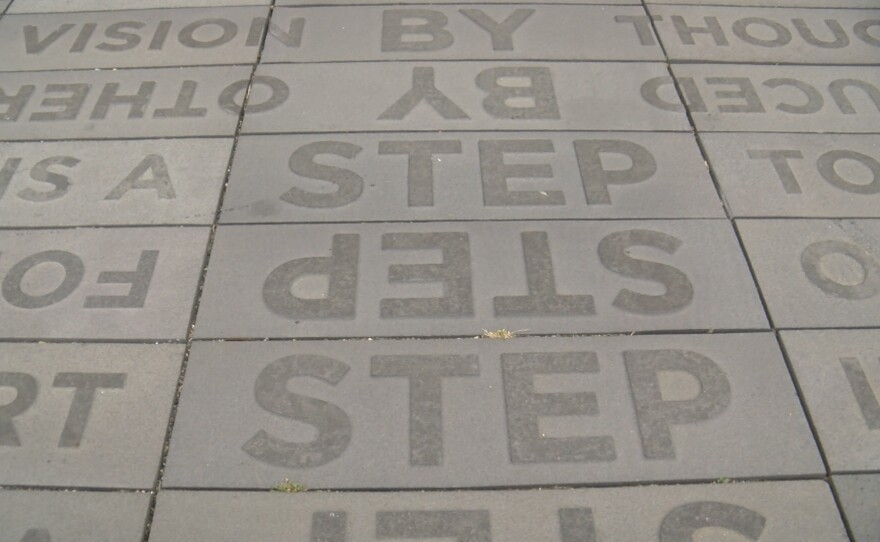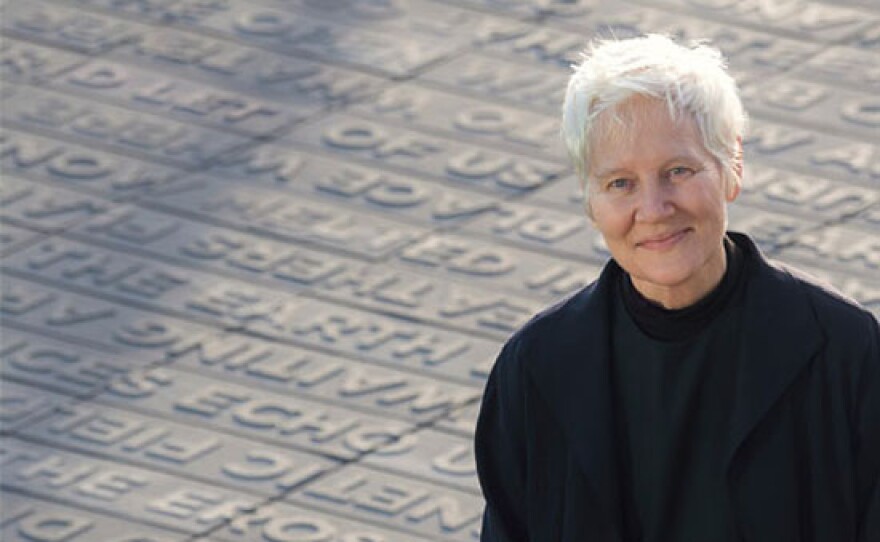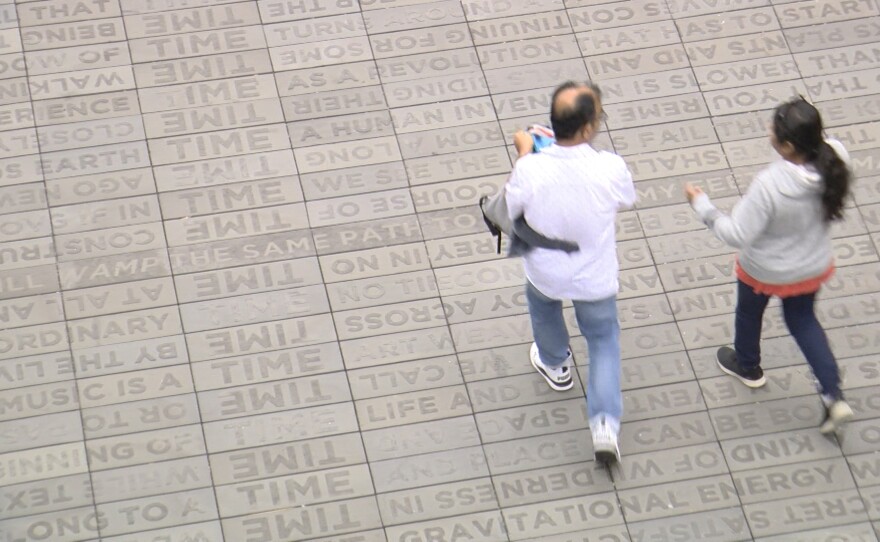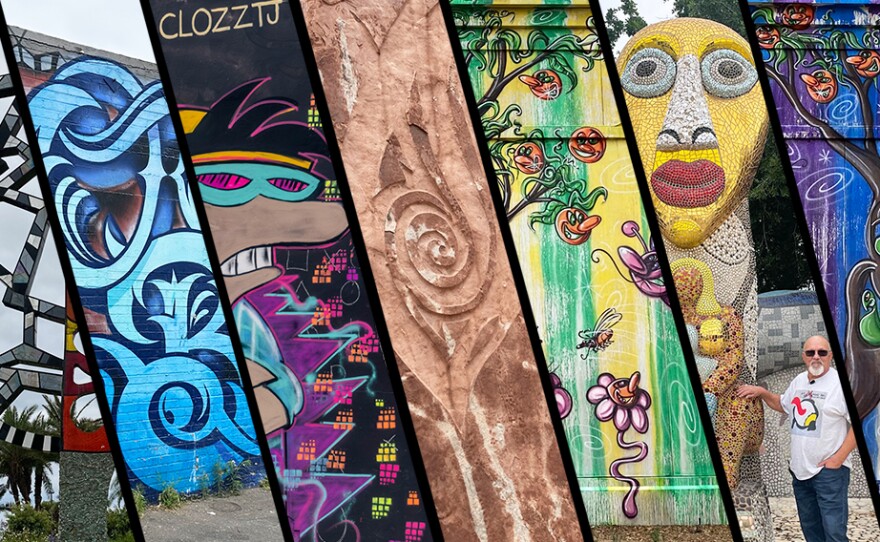Note: This story is part of an ongoing series about public art in the San Diego region.
Most people probably think of art as something hanging in a gallery and not to be touched. But Ann Hamilton designed her public art piece KAHNOP: To Tell a Story as art to be walked on every day by hundreds of students entering the UC San Diego campus. Her work is the latest addition to the Stuart Collection.
When you walk onto the UC San Diego campus from the trolley you are greeted by a story that unfolds over an 800-foot pathway made up of 20,000 handcrafted pavers each bearing a single textured word like braille under your feet.

"So some people have commented that when they step into the walkway — because you step into an artwork — that you may not notice," said Jessica Berlanga Taylor, director of the Stuart Collection. "That is definitely a reality. But maybe you'll notice it when you start walking because there is a sculptural quality to the artwork. And you feel the words. Maybe your eye catches a word and that will then connect you to a phrase."
Some words on the pavers are raised like a rubber stamp, while others are engraved into the basalt stones.
The Stuart Collection is unique among U.S. universities in the way it commissions site-specific public art for the campus.
Mary Beebe was the collection’s first director back in 1981. In a 2016 interview, she noted the purpose of the collection is not to decorate the campus as if it were your living room. She referred to a quote from Kiki Smith, one of the Stuart Collection artists.

"Kiki said, 'It's really important to have something inexplicable every day in your life.' So that's what the art kind of is. It's inexplicable," Beebe said. "You scratch your head and say, 'What could this be about?' Which I think is really good, and especially in an educational environment."
Public art of this kind explodes the boundaries of conventional art by making it accessible to everyone in spaces where you can touch it, walk over it, listen to it or maybe never notice it. And that’s fine with artist Ann Hamilton who created "KAHNOP: To Tell a Story."

"Whether you recognize it as art is maybe less important than you just recognize that you've been touched and that your unattention has been drawn," Hamilton said. "And I think that's actually where the art forms. So I love the fact that people are walking on it and touching it. And over time that will become its own document of wear."
When you go to a museum or a gallery, it is a destination where you expect to find art.

"But when work is placed in public, in different contexts, I think what it does is it invites a kind of what I might call an act of finding, something that you didn't expect, that you find and in that finding a whole experience unfolds," Hamilton said.
KAHNOP unfolds its story with "spine words" running down the center of the pathway.
"It starts 'step by step, now becomes then.' And so that's a sequence of words that I composed that really just refer to the act of walking through the landscape and across this surface," Hamilton said.
There is also a Kumeyaay story that provides a continuous narrative running through KAHNOP.
"The title comes from the collaboration with the two Kumeyaay women's scholars, Dr. Alexandria Hunter and Eva Trujillo, who wrote a creation story embedded into the walkway," Berlanga Taylor explained. "KAHNOP means to tell a story. So we're using the Kumeyaay word and the English word."

But also embedded in the 800-foot-long pathway are 1,300 quotes from an estimated 300 sources connected to UC San Diego.
"What's contained in the walkway are a series of quotes and sentences, fragmented most of the time, from the work of many scholars at UCSD," Berlanga Taylor said. "And from many disciplines like visual arts, literary arts, music, neuroscience, neuro-philosophy, medicine. So the location is important because it is now the main entrance to the campus and is directly connected to the knowledge that UCSD has produced throughout the years."
But again, people may walk over the path and never notice the words they are walking over or they might step onto the path after doing a recital and suddenly see the word "sing." Every person's experience will be different.
"It's the words that catch your attention and the sequences that those end up being placed in your attention because of the pace of walking, that each passage across it is its own composition," Hamilton said. "Just as each student entering the labyrinth of the university is really in many ways making their own program."
But Hamilton hopes maybe the words will send you down a rabbit hole that will lead you to the Geisel Library website.
"They have a website that actually has each line referenced by its spine word," Hamilton said. "And you can actually go to the text at its location in the library if you're interested in dipping further down, kind of like found footnotes."
And who better to find footnote than students? Which is another reason the campus provides a perfect setting for public art.

"You have a culture that's ready to embrace the questions and ready to embrace the experiment that these works are," Hamilton said. "I would say that's probably not an atmosphere you always find in other public realms. And so the more public art or the more arts that are inhabiting the every day of people, I think I would say the stronger the culture we're making is."
Public art is less about whether you like something or not and more about what do you think about it, or how does it make you feel. And the Stuart Collection is about placing a diverse array of art on campus where you can notice it or just skateboard over it to class.








